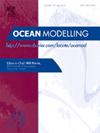海洋深度学习模型的可预测性研究——以黑潮入侵南海为例
IF 2.9
3区 地球科学
Q2 METEOROLOGY & ATMOSPHERIC SCIENCES
引用次数: 0
摘要
许多先前的研究已经深入研究了数值模式中大气和海洋的可预测性,这对于指导和改进预测至关重要。目前,深度学习预测模型发展迅速,但其可预测性在很大程度上仍未被探索。本文以南海黑潮入侵(KI)为研究对象,利用条件非线性最优摄动(CNOP)方法探讨深度学习模型的可预测性。我们首先构建了基于Unet的KI预测深度学习模型,该模型可以很好地预测KI的提前期为14天。通过将该模型与非线性优化算法相结合,我们计算了两种类型的海面高度异常:一种海面高度异常(SSHA)误差为正,记为CNOP1,另一种海面高度异常为负,记为CNOP2。这些CNOP误差可以快速增长并对KI预测产生显著影响:cno1倾向于产生反气旋SSHA误差,该误差与黑潮的环路路径一致,从而放大了入侵,而cno2的作用几乎相反。利用CNOP误差的空间结构识别出敏感区,主要分布在吕宋海峡附近。减少CNOP敏感区域的输入数据误差,相对于遮挡法识别的敏感区域和其他人为确定的敏感区域,能更显著地提高KI预测,相对改进率超过20%。这些发现有可能提升深度学习模型的KI预测技能。本文章由计算机程序翻译,如有差异,请以英文原文为准。
The predictability study of oceanic deep learning models: Taking Kuroshio intrusion into South China Sea as an example
Many previous studies have delved into the predictability of atmosphere and ocean in numerical models, which are crucial for guiding and improving predictions. Currently, deep learning prediction models have developed rapidly, yet their predictability remains largely unexplored. This study endeavors to probe the predictability of deep learning models by focusing on the Kuroshio intrusion (KI) into the South China Sea, utilizing the Conditional Nonlinear Optimal Perturbation (CNOP) approach. We first construct a deep learning model for the KI prediction based on the Unet, which can well predict the KI with a lead time of 14 days. By integrating this model with a nonlinear optimization algorithm, we calculate two types of CNOPs: one with a positive sea surface height anomaly (SSHA) error, denoted as CNOP1, and another with a negative error, labeled as CNOP2. These CNOP errors can grow quickly and exert significant effects on the KI prediction: CNOP1 tends to yield an anticyclonic SSHA error, which aligns with the loop path of the Kuroshio, thereby amplifying the intrusion, while CNOP2 has an almost opposite effect. Furthermore, the sensitive area is identified by the spatial structure of the CNOP error, which is mainly located around Luzon strait. Reducing the input data errors in the CNOP sensitive area will more remarkably improve the KI prediction with a relative improvement rate surpassing 20%, compared to the sensitive area identified by occlusion method and other artificially determined areas. Such findings have the potential to elevate the KI prediction skills of deep learning models.
求助全文
通过发布文献求助,成功后即可免费获取论文全文。
去求助
来源期刊

Ocean Modelling
地学-海洋学
CiteScore
5.50
自引率
9.40%
发文量
86
审稿时长
19.6 weeks
期刊介绍:
The main objective of Ocean Modelling is to provide rapid communication between those interested in ocean modelling, whether through direct observation, or through analytical, numerical or laboratory models, and including interactions between physical and biogeochemical or biological phenomena. Because of the intimate links between ocean and atmosphere, involvement of scientists interested in influences of either medium on the other is welcome. The journal has a wide scope and includes ocean-atmosphere interaction in various forms as well as pure ocean results. In addition to primary peer-reviewed papers, the journal provides review papers, preliminary communications, and discussions.
 求助内容:
求助内容: 应助结果提醒方式:
应助结果提醒方式:


